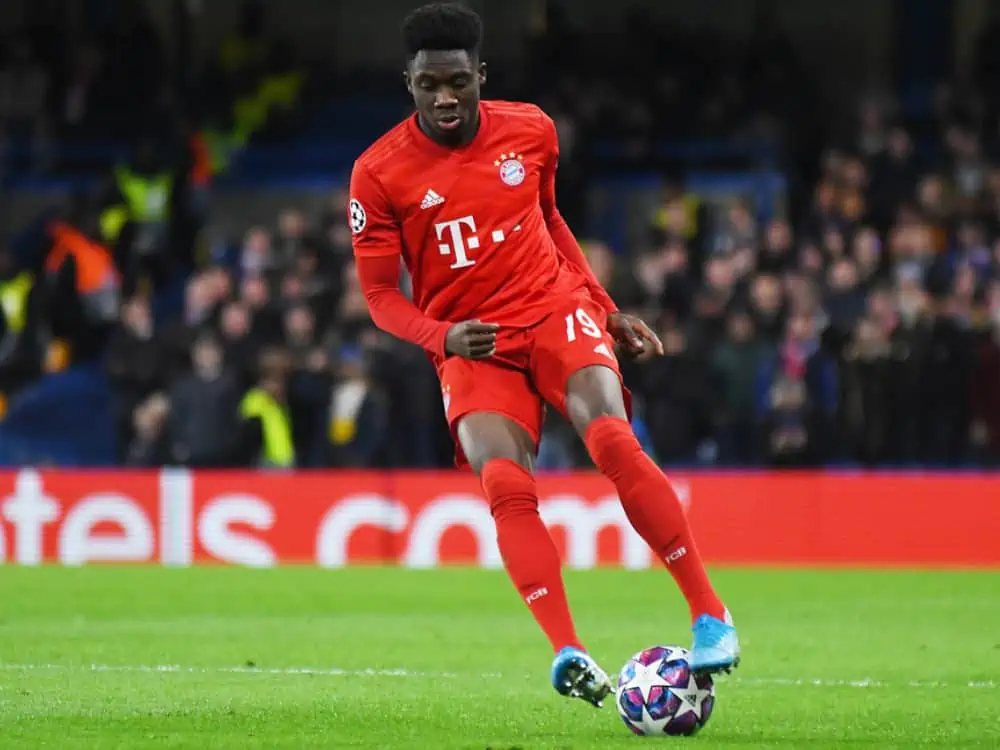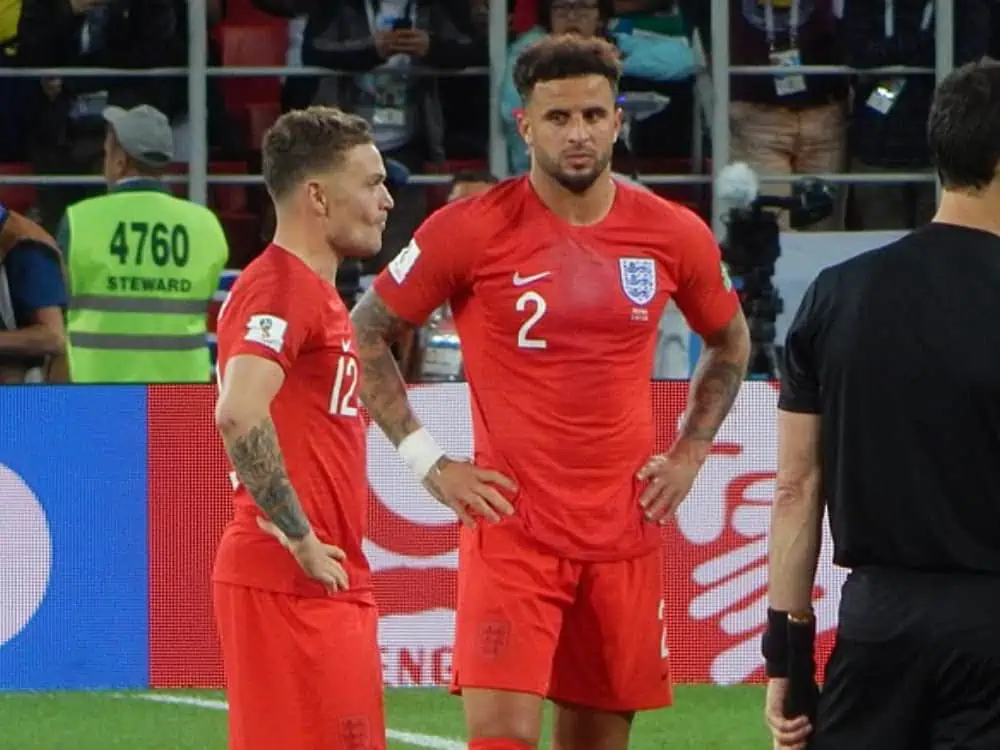Share the post "What Is a Fullback in Soccer (Skills Required)"
Fullbacks are key defensive players that are growing in influence in the modern game. While they don’t always make the headlines, fullbacks work diligently behind the scenes, guarding speedy wingers and covering for teammates.
This position is constantly developing. Many modern teams use their fullbacks like wingers, encouraging them to contribute to attacks.
In this article, we’ll take an in-depth look at the fullback position, identifying its key responsibilities and characteristics. Important areas of focus include:
- What a fullback is
- Types of fullbacks
- How to play as a fullback
- The Best Fullbacks

What Is a Fullback In Soccer?
A fullback is a defender that plays on the right or left side of the backline. Fullbacks are typically referred to as either right backs or left-backs. Their main role is to defend the wide areas and offer attacking support to the wingers and midfielders.
In a back 4, teams play with 2 fullbacks. However, other formations that deploy 3 or 5 player backlines typically operate with wingbacks rather than fullbacks.
Why Are They Called Fullbacks soccer?
In the early days of professional soccer, teams often played with only two defenders, called fullbacks. Ahead of the fullbacks, there were center halfbacks. Over time, strategies changed and halfbacks began to play deeper in defense, occupying the central positions.
This pushed the original fullbacks into the wider areas of the field. Despite the formation changes, left and right-sided defenders continued to be called fullbacks.
Soccer Fullback FAQs
How Important Is A Fullback?
A fullback plays an important role in every team, defending opposition wingers and covering back post overloads. As with most positions, the extent of their importance comes down to team tactics, the individual player’s skill level, and in-game impact.
In some teams, the fullback is one of the least important positions. It’s quite common for teams to play center-backs, wingers, or even midfielders in fullback positions.
However, many modern teams design their entire attacking systems around their fullbacks. In this type of tactical shape, the fullbacks are responsible for creating width, utilizing the available space, and direct chance creation.
Jurgen Klopp’s Liverpool team relies heavily on their fullbacks for goals and assists. Their main fullbacks, Andrew Robertson and Trent Alexander-Arnold have provided the most assists for Liverpool in the past 4 consecutive seasons:
| Season | Trent Alexander-Arnold | Andrew Robertson |
| 21/22 (*April) | 11 | 10 |
| 20/21 | 7 | 7 |
| 19/20 | 13 | 12 |
| 18/19 | 12 | 11 |
Speaking about his fullbacks, Klopp had this to say:
“This kind of full-back now is much more of a midfield player. The kind of football they play, in halfspaces, they are the other winger sometimes, the central midfielder sometimes…The rule is: be an option, get the pass or be available for other players.”
Jurgen Klopp, 2016
Is Fullback A Good Position Soccer?
A fullback is a good position to play in soccer. For young players, it is a position that allows skill development. Fullbacks typically have more time on the ball than midfielders or attacking players, who play in congested areas of the field.
Although their main focus is on defending, fullbacks get the opportunity to attack, particularly those with a more well-rounded skill set. We often see players learn their trade-in fullback positions before moving into different roles.
Gareth Bale started out as a left-back for Southampton and Tottenham before turning into one of the most electrifying wingers of his era. His breakout hat-trick performance against Inter Milan in the 2011 Champions League put the soccer world on alert.
Fabinho, Liverpool’s midfield anchor is arguably the finest defensive midfielder in the Premier League. However, the Brazilian spent many of his early professional years as a right-back for Monaco.
How Do You Play Fullback In Soccer?
To play as a fullback, you need to be defensively minded, disciplined, and hard-working. Let’s take a look at some of the key attributes of fullbacks today.
What Is The Job Of A Fullback In Soccer?
Fullbacks have a mixture of defensive and attacking jobs, operating mainly along the sidelines. They defend against the opposition’s wingers and help start up attacks from the back.
While the specific role of a fullback varies from team to team, their general responsibilities include:
- Defending opposition attackers in wide areas, keeping them as far away from goal as possible, preventing them from crossing the ball, and creating chances.
- Defending the back post when the opposition is attacking from the opposite side.
- Providing a passing outlet for the goalkeeper, center backs, wingers, and midfielders.
- Making supporting runs, becoming a creative attacking option, and opening up space for teammates.
- Overlapping wingers and providing crosses for strikers and attackers.
- Taking throw-ins.
- Maintaining the team’s defensive shape and holding a strong offside line.
- Cutting infield and attacking from central areas.
What Makes A Good Fullback?
Fullbacks come in a variety of shapes and sizes, displaying a range of skills and physical attributes. Although physical characteristics are important in all athletic competitions, successful fullbacks must have particular personality traits. Some common qualities of a good fullback include:
- Defensive aggressiveness, intensity, and tenacity.
- Stamina and speed to keep up with speedy opposition wingers.
- Excellent work ethic.
- Good timing for tackling and 50/50 situations.
- Positional sense and defensive intelligence.
- Accurate crossing for creating chances.
If the fullback is given offensive responsibilities, they must have good technical abilities. Attacking fullbacks should be able to dribble, pass, and cross comfortably. They must also possess the pace and skill to dribble past a defender in a 1 v 1 situation.
How Do You Defend As A Fullback?
Defending as a fullback can be divided into five important categories: reading the game, movement and positioning, technical defending, physicality, and 1 v 1s.
1. Reading The Game
Fullbacks must be alert at all times to read the game. This allows them to anticipate over-the-top passes, measure through balls, and prepare for switches of play. Fullbacks must be in constant communication with their defensive teammates, ensuring their positioning is in sync.
We frequently see fullbacks losing concentration when the ball is on the opposite wing, playing the opposition striker onside, leading to a goal.
2. Movement And Positioning
Reading the game well is useless without correct movement and positioning.
A good backline moves as a unit, ensuring all players are in the right position to cover for each other and stop the opposition’s attacks.
Fullbacks stay in wide positions when defending their side. However, they must tuck in closer to their center back when the ball is on the opposite flank.
In possession, fullbacks must be able to support their teammates without overexposing the backline to counterattacks. Positioning during transitions is essential for a good fullback.
3. Technical Skills
Technical proficiency is important for fullbacks, particularly when it comes to tackling, defensive jockeying, and marking.
Defenders should never stand “square”. Instead, they defend at an angle, ensuring they can move or change direction quickly without falling. Although slide tackling is an important technical skill for a defender, the most efficient fullbacks tend to stay on their feet to avoid risks.
4. Physicality
Physicality is an important aspect of defending. Even if a fullback is small in stature, they must be aggressive and physical to compete with opposition attackers. Core strength, stamina, and balance weight size over a 90-minute game.
5. 1 v 1 Defending
Good 1 v 1 defending skills help keep fullbacks off Youtube highlight reels. While it may look like 1 v 1 defending is all about tackling and matching physicality, this is not the case. Positioning and timing are the two most important factors in 1 v 1 situations.
If you’re already close to your opponent when they receive the ball, they don’t have time to build momentum or assess their options. If you’re out of position, your opponent can turn, get their head up, and utilize the space to beat you with a dribble.
Many tricky wingers wait for the fullback to commit to a challenge before knocking the ball past them and continuing their run.
In 1 v 1 scenarios, fullbacks should be patient, guiding their opponent away from the goal, slowing their momentum, and closing the distance before timing their tackle.

Are Fullbacks Fast?
Many fullbacks are blisteringly fast. Since their primary responsibility is to defend the sidelines, they must have the pace to keep up with attackers.
Fullbacks that lack speed are often targeted by opposition teams. Slow full backs must compensate with strength, aggression, and positional sense. Interestingly, fullbacks have clocked the highest speeds in world football in recent years.
- Alphonso Davies, topped out at 22.68 mph during one of his signatures runs for Bayern Munich, while Achraf Hakimi was recorded hitting 22.66 mph in 2020 (playing for Borussia Dortmund).
- To give this context, Usain Bolt’s average speed during his world record 100m sprint was 23.35 mph.
Does A Fullback Run The Ball?
Some fullbacks are excellent dribblers, progressing the ball and leading counterattacks at every opportunity. As soccer continues to become more stats-focused, we’re seeing progressive carries as an increasingly important statistic. 7% of progressive ball carries end in a shot.
Although most progressive carries come centrally or through attacking players, the best teams in Europe use deep carrying fullbacks to set up attacks.
In fact, fullbacks from Manchester City, Bayern Munich, Liverpool, and Barcelona spend over 30 minutes per game in the final third of the field.
Fullback Vs Wingback
Fullbacks usually play as part of a back 4, operating as defense-first players. Wingbacks are far more attacking since they play either side of three center-backs.
Wingbacks occupy more advanced positions on the field and usually contribute heavily to goal scoring, through assists or direct goals.
Wingbacks can create overloads by attacking the back post for crosses. Many successful teams have used wingbacks in recent seasons, including Chelsea, Bayern Munich, PSG, and Juventus.
Best Fullbacks In Soccer
We’ve put together a list of the best fullbacks in soccer based on market value, defensive efficiency, and attacking output. The list contains a combination of young and experienced players, including supreme talents to look out for in the coming seasons:
| Player | Team |
| Trent Alexander-Arnold | Liverpool |
| Joao Cancelo | Manchester City |
| Achraf Hakimi | PSG |
| Kyle Walker | Manchester City |
| Reece James | Chelsea |
| Benjamin Pavard | Bayern Munich |
| Dani Carvajal | Real Madrid |
| Jordi Alba | Barcelona |
| Alphonso Davies | Bayern Munich |
| Ferland Mendy | Real Madrid |
| Raphael Guerreiro | Borussia Dortmund |
| Andrew Robertson | Liverpool |
Share the post "What Is a Fullback in Soccer (Skills Required)"
Joel is a seasoned soccer journalist and analyst with many years of experience in the field. Joel specializes in game analysis, player profiles, transfer news, and has a keen eye for the tactical nuances of the game. He played at various levels in the game and coached teams - he is happy to share his insight with you.



